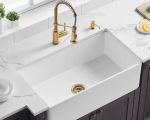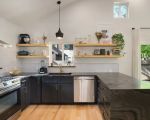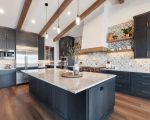How to Remodel a Home for Aging in Place: A Comprehensive Guide
As we grow older, the idea of staying in our homes rather than moving to a new space becomes increasingly important. Many of us want to remain in the comfort of our own homes as we age, but this desire often requires making modifications to ensure that the environment is safe, accessible, and comfortable. This process is known as “aging in place,” and it involves remodeling your home to accommodate your changing needs. In this article, I will walk you through the steps of remodeling your home for aging in place, share real-world examples, and provide helpful tips to make this transition as smooth as possible.
1. Understanding the Concept of Aging in Place
Aging in place refers to the ability to live in your own home safely and independently as you age, without the need to move to a senior living facility or a nursing home. It’s a philosophy that embraces the idea of creating an environment where older adults can continue to enjoy their daily lives with the support of accessible and easy-to-use features in their home. Remodeling for aging in place focuses on addressing the challenges that may arise as we get older, such as mobility issues, vision impairment, and limited physical strength.
When I first started thinking about remodeling my own home for aging in place, I quickly realized that it was about more than just making a few aesthetic changes—it was about ensuring safety, accessibility, and convenience. With the right adjustments, I could make my space more comfortable and functional for the long term. Here’s how I approached the process and what I learned along the way.
2. Start with a Home Assessment
The first step in remodeling a home for aging in place is conducting a thorough assessment of your current living space. This involves identifying potential hazards, areas that may need modification, and spaces that are not as accessible as they could be. During my own assessment, I started by looking at the basic layout of my home, paying particular attention to the entryways, bathrooms, kitchen, and living areas.
For example, I realized that the stairs leading to my front door would be difficult to navigate if I were to use a walker or wheelchair in the future. This led me to consider installing a ramp for better accessibility. Additionally, I assessed the lighting in my home, ensuring that hallways, staircases, and entrances were well-lit to prevent falls. By taking the time to evaluate my home’s layout and functionality, I was able to make informed decisions on what changes would be necessary.
3. Focus on Mobility and Accessibility
One of the key components of remodeling a home for aging in place is ensuring that it’s accessible. This includes widening doorways, eliminating obstacles, and making sure rooms are large enough to accommodate walkers, wheelchairs, or other mobility devices. I decided to start with the most commonly used areas of the home, such as the kitchen, bathroom, and bedroom.
In my kitchen, I replaced lower cabinets with pull-out shelves for easier access to items. I also installed a no-threshold shower in the bathroom, which is safer and easier to navigate than a traditional bathtub. These changes made my home more user-friendly and adaptable to future needs. In the bedroom, I lowered the bed and created more space around it to accommodate mobility aids. These small adjustments can make a huge difference in enhancing daily life.
4. Install Safety Features to Prevent Accidents
Safety should always be a top priority when remodeling for aging in place. As we age, our risk of falling increases, so it’s important to take proactive steps to prevent accidents. I started by installing grab bars in key areas, including the bathroom and by the stairs. These provide support and stability when moving around, particularly in wet areas where slips are more likely to occur.
Additionally, I added non-slip mats and rugs throughout the house, especially in the bathroom and kitchen. The flooring is another important consideration—slippery floors can be a major hazard, so I opted for textured surfaces in areas where there is frequent moisture. Ensuring that hallways and bathrooms are free of clutter also goes a long way in preventing tripping hazards.
5. Adapt the Kitchen for Easier Cooking and Meal Preparation
For those who enjoy cooking, the kitchen is an essential space to consider when remodeling for aging in place. After all, meal preparation can become more challenging as mobility and dexterity decrease. I made several key adjustments to make my kitchen more accessible, such as lowering countertops and installing pull-down shelving for easier access to high cabinets.
I also added a side-by-side refrigerator for easy access and an oven with side-opening doors to reduce the need to bend down. These changes made cooking more comfortable and less physically demanding. When planning your own kitchen remodel, think about what adjustments would make the most sense for your lifestyle and mobility needs. The goal is to make cooking enjoyable and stress-free.
6. Invest in Smart Home Technology
Incorporating smart home technology into your home remodel can provide convenience and increased safety. I found that devices like voice-activated assistants, smart thermostats, and motion-sensor lights can make a big difference, especially when mobility or vision is impaired. For example, I installed a smart thermostat that I could control from my phone, allowing me to adjust the temperature from anywhere in the house without having to move. I also added smart lights with motion sensors, so I no longer had to fumble for light switches in the dark.
Additionally, I invested in smart door locks and security cameras, which gave me peace of mind knowing that I could monitor my home remotely. These technologies are not only practical but can also enhance your overall quality of life by making everyday tasks simpler and more efficient.
7. Embrace Universal Design Principles
When remodeling your home for aging in place, it’s essential to consider universal design principles. This approach focuses on creating spaces that are usable by people of all ages and abilities. One example of this is the concept of “barrier-free design,” which eliminates physical barriers that might impede movement. I chose to incorporate wide doorways and open floor plans, ensuring that furniture could be rearranged if necessary to accommodate mobility aids.
Universal design also emphasizes the importance of lighting and clear signage to help with navigation. I added well-marked pathways and easy-to-read labels on light switches and door handles. These thoughtful touches not only make my home more accessible but also create a more comfortable and welcoming environment.
8. Working with a Professional: Expert Advice
Throughout my remodel, I consulted with experts who specialized in aging in place and universal design. Their advice was invaluable in helping me create a home that met my future needs. Working with a professional can ensure that your remodel is done correctly and that all safety standards are met. They can also recommend the best products and materials that are both durable and functional for aging in place.
If you're considering remodeling your home to age in place, I highly recommend consulting with a professional. They can help you navigate the complex design decisions and provide insight into creating a comfortable, functional living space that you can enjoy for years to come.
For more tips and expert advice on aging in place and home improvement, visit Improvement for all your remodeling needs.
SEO Title: How to Remodel a Home for Aging in Place: A Complete Guide SEO Keywords: remodeling for aging in place, aging in place home improvements, home modifications for seniors, universal design, aging in place home remodel SEO Description: Learn how to remodel your home for aging in place. This guide offers practical tips and expert advice on creating a safe, accessible home for seniors and individuals with mobility challenges.







